5 Best AI Workflow Automation Tools in 2025
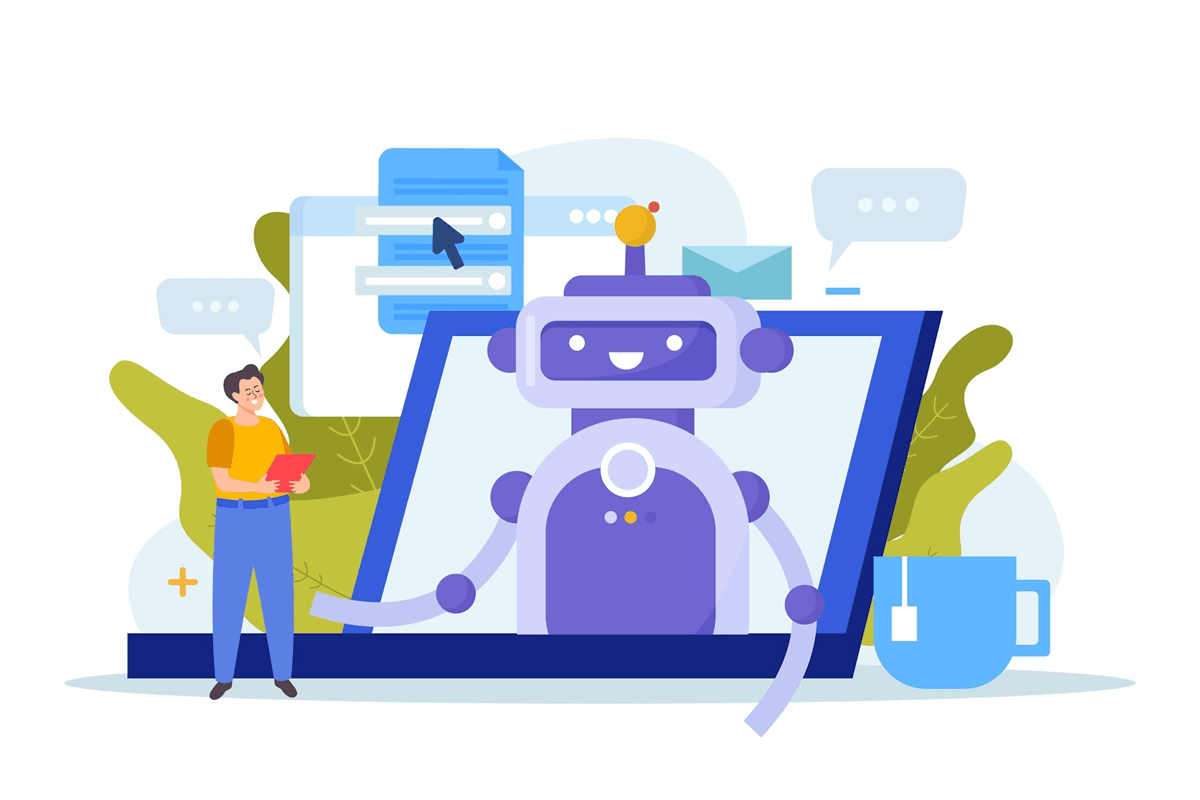
Every week, hours slip away on manual data entry, file updates, and routine follow-ups. Maybe your team has tried traditional automation tools to cut the workload. But is it enough? Or do you still feel stuck as your business processes grow more demanding?
With the rise of AI workflow automation tools, you finally have options that go further. These new tools can manage complex workflows, reduce mistakes, and give you back 10+ hours each week.
That extra time means your team can focus on closing deals, supporting customers, or hitting the next milestone.
In this guide, you’ll see five workflow automation tools compared side by side.
Try Activepieces for free today and see how much time you get back in your week!
How AI Workflow Automation Tools Transform Your Business Processes
Traditional marketing automation tools only cover basic shortcuts, but AI workflow automation goes further. These platforms can automate tasks or processes within a workflow, learn from data, and improve results over time.
Artificial intelligence removes routine tasks like scheduling, reporting, and updating. That time goes back to your team so they can tackle more complex tasks that drive growth.
Besides that, AI tools use predictive analytics to spot risks early and suggest the best action. With natural language processing (NLP) for understanding human inputs, your staff can use plain commands instead of code.
Growth is no longer tied to headcount. By adopting AI technologies, you rise faster without adding the same number of people. AI agents are a new type of workflow automation built to adapt as your processes shift.
You can already see the results:
- Banks shorten compliance work from weeks to days.
- Retailers process thousands of seasonal orders without extra staff.
- Manufacturers use predictive maintenance to stop downtime before it starts.
According to McKinsey, current generative AI and similar technologies could automate up to 70% of employees’ time.
5 AI Workflow Automation Tools That Free Your Team’s Time
The following are five AI workflow automation tools that improve how your business operates day to day.
1. Activepieces
With basic automation platforms, you’re forced into extremes: either stripped-down features that can’t scale or developer-heavy setups that slow everyone else down.
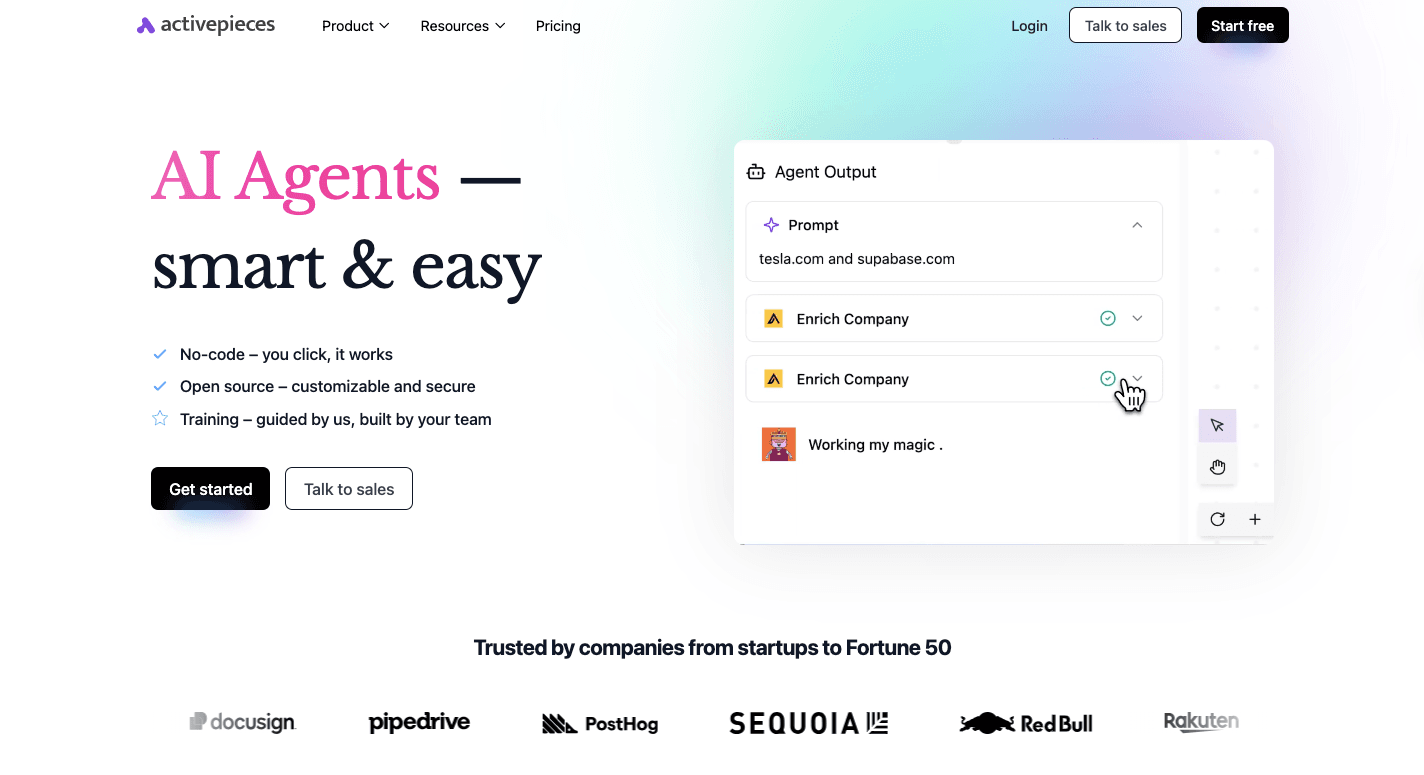
Activepieces is different. It gives your team a friendlier way to run automated workflows while still packing the depth that big companies demand. For your non-technical users, a no-code builder is available, while developers can push further with TypeScript pieces.
Security and control are baked in. Activepieces provides:
- Self-hosting
- Enterprise-grade security with flexible deployment options for highly regulated industries
- Strict access controls
At the same time, it handles data management with built-in tables, logs, and project-based separation so your flows stay organized. The result is faster automation, fewer mistakes, and happier teams.
With over 379+ integrations and the ability to build custom AI agents tailored to your unique business needs, Activepieces offers unmatched flexibility and limitless scalability, far surpassing traditional automation tools that quickly reach their limits.
The outcome is clear: less manual work, higher customer satisfaction, and automation that keeps pace with your goals.
Key Capabilities
Activepieces gives you the features you expect and a lot you didn’t know you needed:
- No-code builder – Build flows in minutes with drag-and-drop steps.
- TypeScript pieces – Extend any integration with developer control.
- Copilot – AI assistant to suggest and refine your workflows.
- AI SDK – Build AI agents that handle unique business needs.
- Human-in-the-loop – Add reviews, approvals, or pauses where needed.
- Tables and storage – Track lists, history, and state right inside the app.
- Cloud or self-host – Use the hosted service or run your own servers.
Integrations
Activepieces already connects with 379 apps and counting. That means you can link marketing, support, finance, AI, and more without waiting months for connectors.
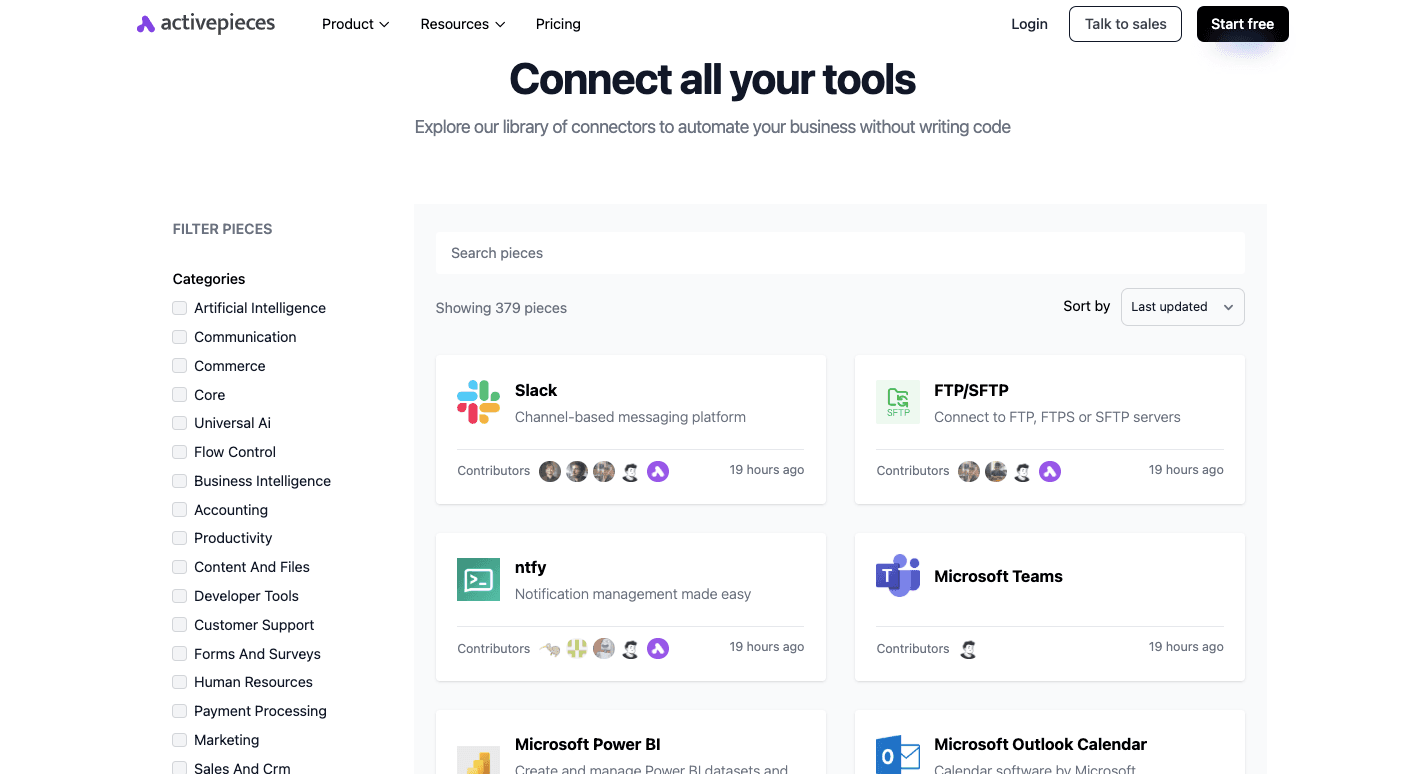
Some highlights include:
- AI services like OpenAI, Gemini, and ElevenLabs.
- Productivity tools such as Google Sheets, Excel 365, Slack, and ClickUp.
- CRM and support with Zoho, Dynamics, and Zoho Desk.
- Finance and BI with Zoho Books, Invoices, and Power BI.
Unlike other platforms, integrations aren’t locked behind paywalls or vendor schedules. Developers and community members constantly add new ones, and Model Context Protocols let AI agents call any of them.
Use Cases
You don’t have to wonder if Activepieces works in real business settings. Here are intelligent workflows teams are already running:
- Nurture leads automatically with personalized touchpoints.
- Route emails so the right person sees them instantly.
- Summarize sales calls into next steps and risks.
- Pull company details and recent news before client meetings.
- Track expenses by grabbing receipts and sending them to finance.
- Screen CVs and build candidate shortlists for HR.
Pricing
Activepieces keeps pricing simple and predictable, so you never worry about hidden costs.
The Free plan includes 1,000 tasks each month, 200 AI credits, two flows, and community support. Then, the Plus plan at $25 per month is aimed at small teams and gives you unlimited tasks under fair use, ten active flows, AI agents, unlimited tables, and 500 AI credits.
For growing teams, the Business plan at $150 per month includes unlimited tasks, 50 active flows, 1,000 AI credits, ten projects, API access, and five user accounts. Larger organizations can choose the Enterprise option, which offers custom resources, advanced features, and dedicated support.
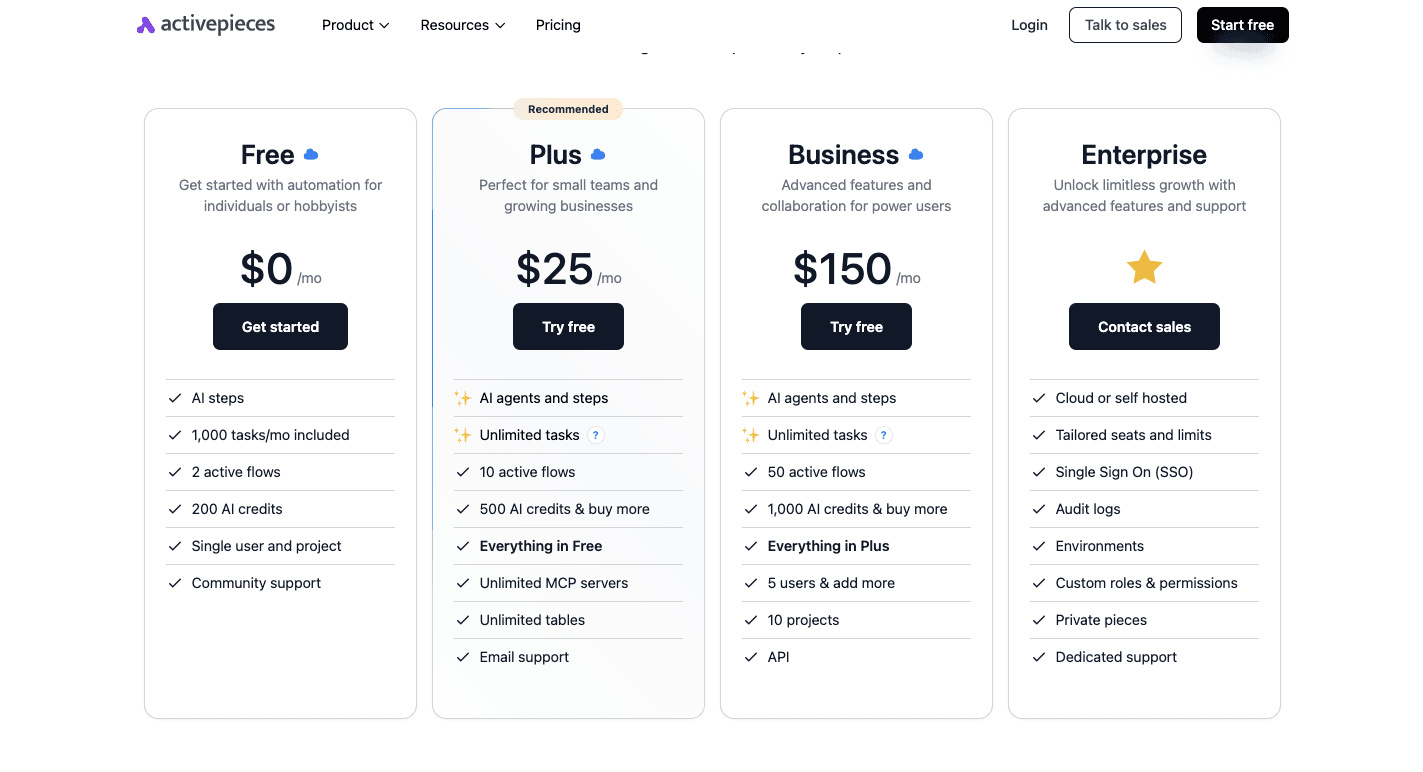
Activepieces offers flat-rate pricing that stays steady as you grow, and the costs don’t rise sharply with task volume. You have the freedom to automate at high volume, and confidence that automation will always fit your budget.
Start with the free plan today, or choose a business plan and put your workflows on autopilot!
2. IBM Robotic Process Automation
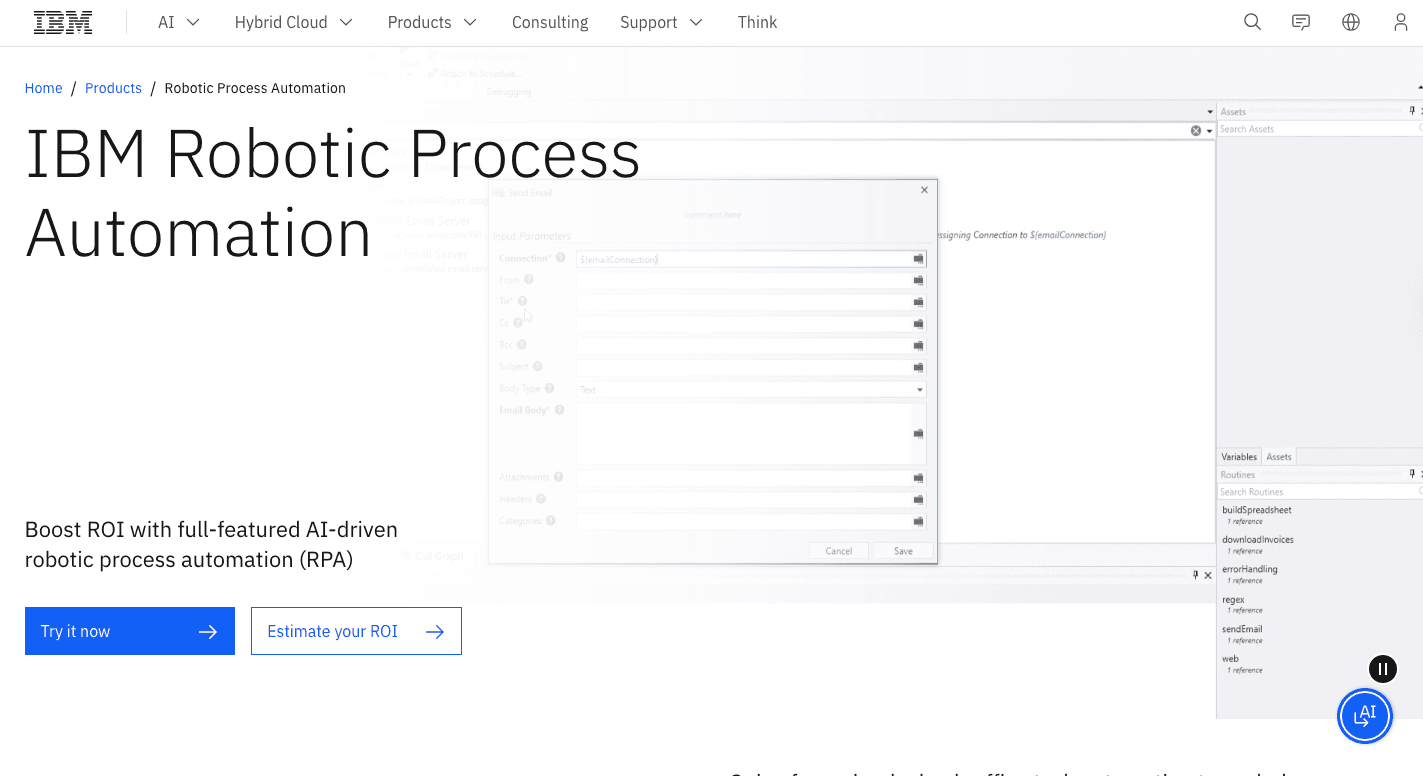 Image Source: ibm.com
Image Source: ibm.com
IBM Robotic Process Automation (RPA) automates manual tasks and streamlines your processes, enabling them to run much faster. It blends bots with AI and works in cloud, on-premises, or container setups. The platform’s purpose is simple: streamline workflows so your staff spends less time on repetitive jobs.
Banks use IBM RPA for compliance checks and high-volume transactions. In retail, the system manages stock levels, order processing, and chatbot-driven customer support.
Healthcare providers rely on it too for prescription refills and insurance claims. Even in general office work, it speeds up reporting, email handling, and document processing.
IBM positions RPA as more than a bot builder. The platform includes AI and OCR tools to handle documents and chat interactions. It also processes mining that lets you see where time is lost and target the right workflows for automation.
Key Features
- Low-code studio – Build bots quickly with drag-and-drop tools or scripts.
- Workflow recording – Capture user actions and turn them into automation scripts.
- Pre-built templates – Use a library of commands and templates for common tasks.
- Attended and unattended Bots – Support your staff in real time or run jobs independently.
- AI and OCR – Add chatbots, text recognition, and document handling.
- Concurrent execution – Run multiple bots at once for higher output.
- Hybrid deployment – Roll out on cloud, local servers, or containers.
Pros
- AI integration includes OCR and chat capabilities.
- Low-code tools let your non-technical staff build automations quickly.
- Compliance and accuracy help in finance and healthcare.
Cons
- Setup and training take more time and resources.
- Bots can break when underlying applications change.
- OCR still struggles with multiple languages.
Pricing
IBM RPA follows a capacity-based licensing model. Companies pay based on the number of bots and concurrent sessions.
3. Microsoft Power Automate
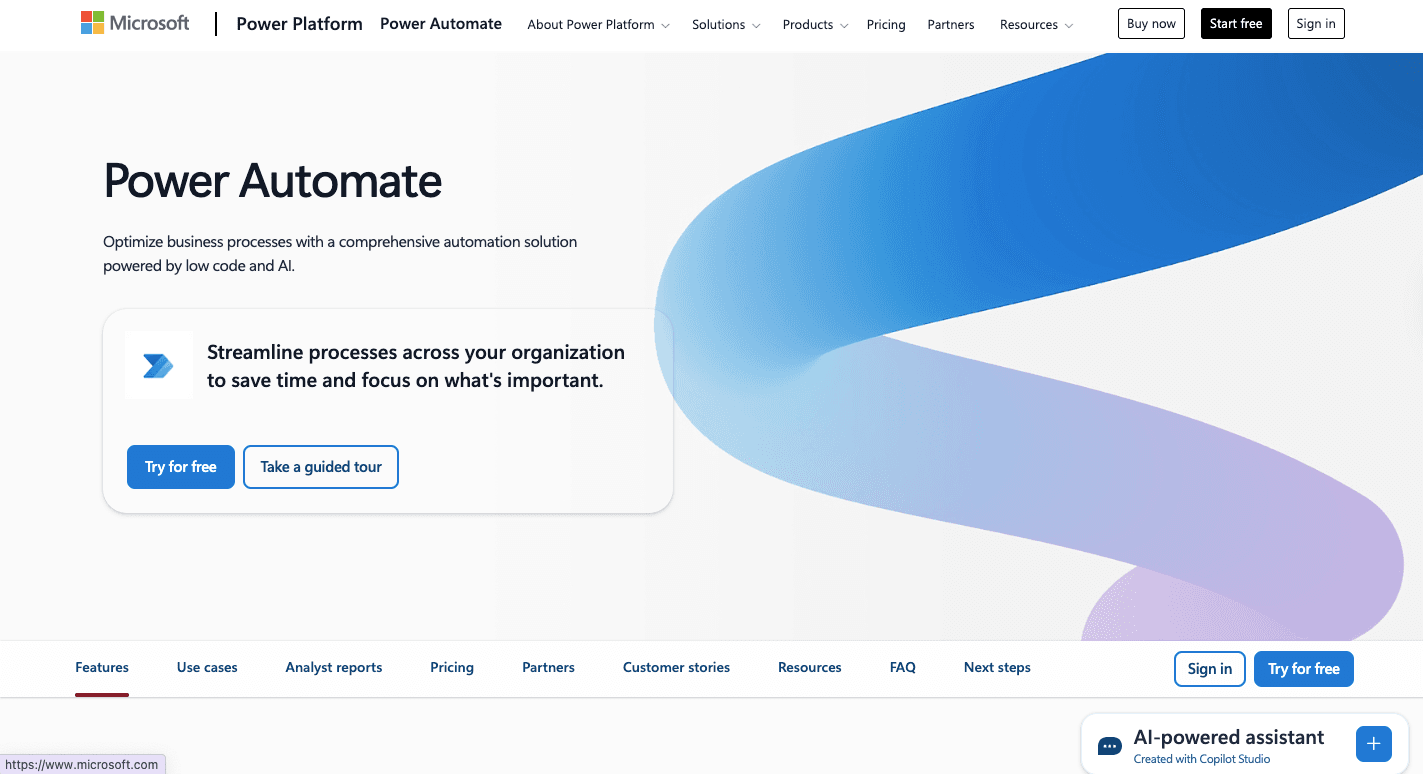 Image Source: microsoft.com
Image Source: microsoft.com
Microsoft Power Automate, previously known as Microsoft Flow, is a cloud service that streamlines tasks, works with real-time data, and connects processes across apps. It sits inside the Microsoft Power Platform with Power Apps, Power BI, and Copilot Studio.
The system works through “flows,” which are triggered by events such as a new email, a button click, or a schedule. These flows then carry out actions like moving files, updating spreadsheets, or sending alerts.
Desktop flows bring in robotic process automation that runs jobs even on older legacy systems that lack APIs. The AI builder adds intelligence with text recognition, image processing, and even Copilot prompts to guide setup.
Using Power Automate, finance teams speed up invoice handling, HR automates onboarding, and sales departments keep customer data and workflows in sync between CRMs and email tools.
Key Features
- Cloud flows – Automations triggered by events, schedules, or manual clicks.
- Desktop flows – Robotic process automation that mimics user actions on desktops or websites.
- Business process flows – Guided steps that ensure consistency across multi-stage processes.
- Work queues – Prioritize and distribute high-volume tasks effectively.
- Connectors – Over a thousand pre-built connections, plus custom options for any API-based service.
- Centralized management – Dashboards for permissions, monitoring, and analytics.
- Data protection – Features like data loss prevention (DLP) policies keep information secure.
Pros
- Deep integration with Microsoft 365.
- Large library of connectors for outside services.
- Low-code interface that works for both IT and non-technical users.
Cons
- Advanced flows require more technical skill to manage.
- Licensing for advanced features can get expensive.
- The interface may feel confusing for new users.
Pricing
Microsoft Power Automate has several pricing tiers. A limited version comes bundled with Microsoft 365, but it only covers basic flows. The Premium plan at $15 per user per month unlocks unlimited flows, premium connectors, and attended RPA.
For larger automation needs, the Process plan at $150 per bot per month supports shared cloud flows and unattended RPA. The Hosted Process plan at $215 per bot per month adds a managed Azure VM for running automations.
All plans are billed annually.
4. UiPath
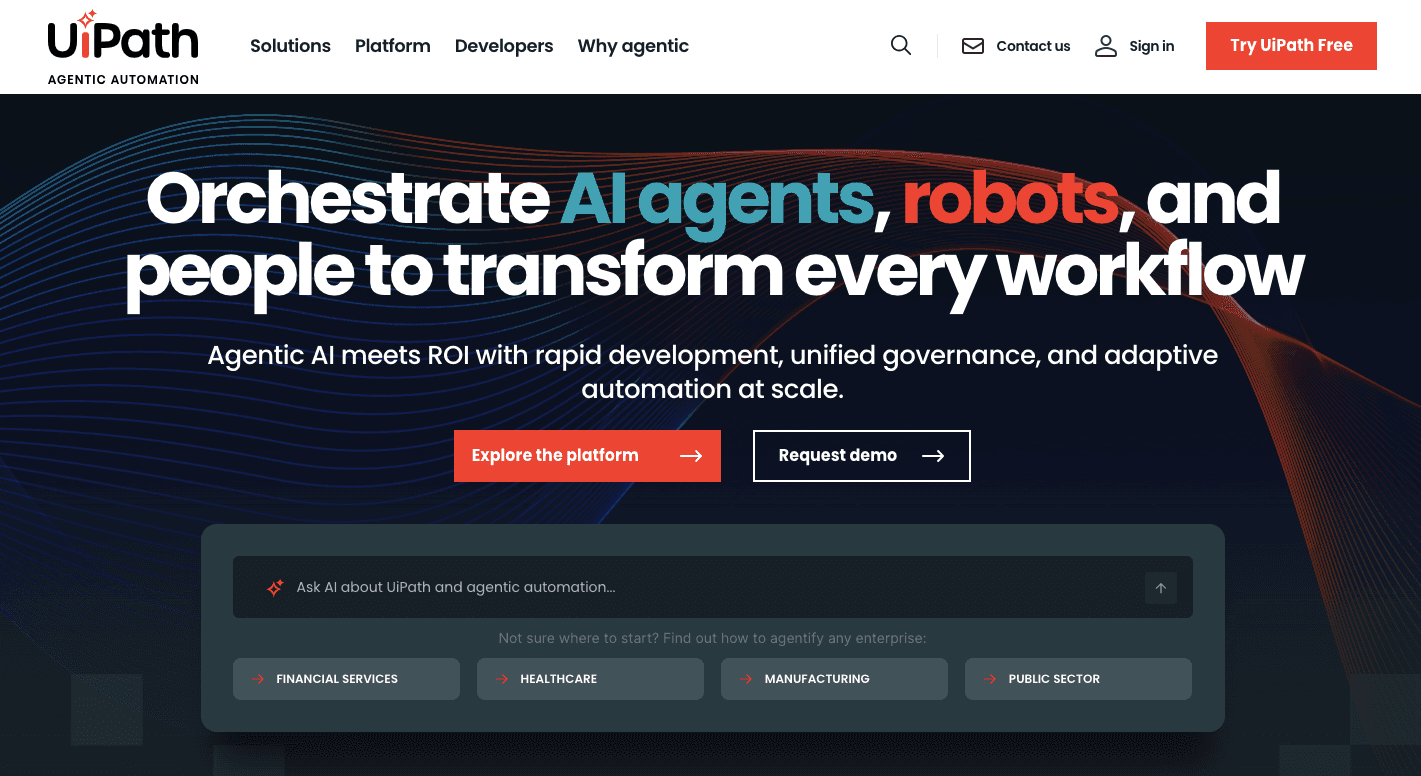 Image Source: uipath.com
Image Source: uipath.com
UiPath covers both simple workflows and enterprise-wide automation projects. Unlike lighter tools, it merges traditional RPA with AI features like document understanding, computer vision, and conversational AI.
There are three building blocks inside UiPath. First is the Studio, a design space where users create automation flows using drag-and-drop tools.
Meanwhile, Robots are the digital workers that carry out the instructions, either alongside you (attended) or fully on their own (unattended). Orchestrator is the control hub that manages schedules, performance, and governance across the entire bot fleet.
Different organizations use UiPath to automate invoices, HR onboarding, IT helpdesk tickets, and even legacy desktop systems. Additionally, the platform offers advanced analytics and seamless integrations with popular applications such as SAP, Salesforce, and Microsoft Office.
Key Features
- Task mining – Analyzes employee activity to highlight new automation opportunities.
- Autopilot – Uses conversational AI to generate code, workflows, or app interfaces from prompts.
- AI center – Deploy and manage machine learning inside your workflows.
- Document processing – Extracts unstructured data from forms, invoices, and contracts.
- Apps – Build custom web-based apps to connect humans and bots.
- Computer vision – Interact with on-screen elements, even in virtualized apps.
- Cross-platform support – Works across desktop, web, and virtualized environments.
- Insights – Provides detailed dashboards to track performance, ROI, and productivity gains.
Pros
- Large community and free learning resources.
- Deployment options are available in cloud, hybrid, or on-premises setups.
- Wide range of integrations with business apps and platforms.
Cons
- Advanced workflows require technical expertise.
- Bots may fail after software or UI changes, which leads to extra fixes.
- Debugging and testing can slow down development cycles.
Pricing
UiPath offers a Basic plan starting at $25 per month, aimed at individual users who need personal automations. The pricing for the Standard and Enterprise plans is not publicly listed and depends on deployment size, number of users, and features.
5. Adobe Sensei
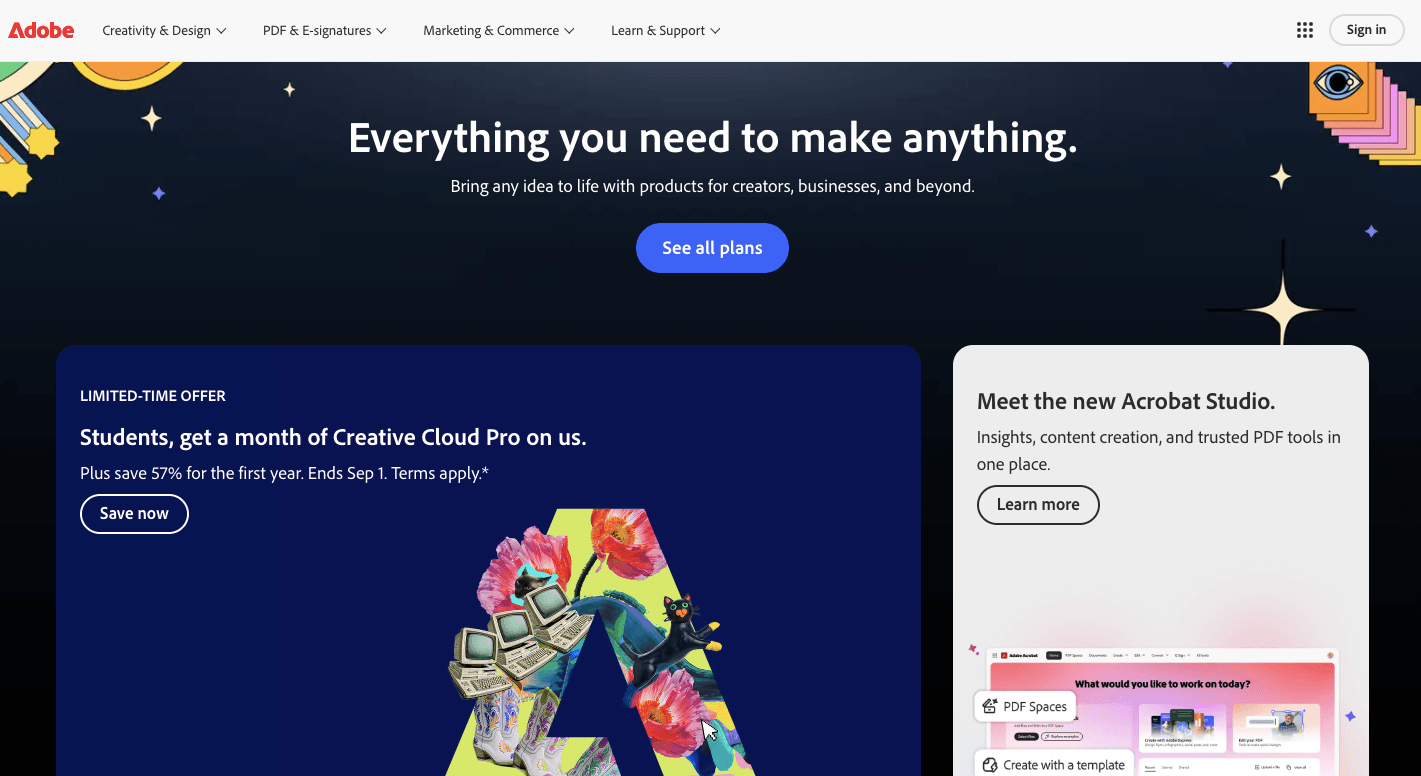 Image Source: adobe.com
Image Source: adobe.com
Adobe Sensei is an AI and machine learning platform that automates tasks and reduces manual effort across creative and business workflows. However, it’s not a standalone product but an intelligence inside Adobe’s Creative Cloud, Document Cloud, and Experience Cloud.
In practice, Sensei supports creators with editing tools that remove objects, colorize photos, or resize videos for different channels. For businesses, it drives analytics, personalization, and content delivery.
Marketers use it to predict customer behavior and segment audiences, while analysts use anomaly detection to catch patterns in data before they cause problems. Document workflows also benefit from features like text recognition and form detection, which speed up reviews and cut errors.
The scope goes beyond creative work. Enterprises use Sensei inside Experience Cloud to recommend products, optimize campaigns, and forecast performance.
Pairing it with other Adobe tools helps with content delivery, project management, and decision-making.
Key Features
- Content-aware fill – Removes unwanted objects from photos and video.
- Neural filters – Applies effects like facial edits or photo colorization in seconds.
- Auto reframe – Resizes and adjusts video for different platforms automatically.
- Firefly – Add, replace, or recolor elements with text prompts.
- Optical character recognition – Converts scanned documents into editable files.
- Form detection – Automatically identifies fields in forms for faster setup.
- Audience segmentation – Groups customer data for targeted campaigns.
- Anomaly detection – Flags unusual patterns in analytics for quicker response.
- Predictive analytics – Forecasts campaign performance and customer behavior.
Pros
- Saves time by automating edits and document tasks.
- Makes advanced effects easy, even for beginners.
- Provides insights for marketing teams using customer data.
Cons
- Advanced tools come with a learning curve.
- Limited integration with third-party apps outside Adobe.
- Resource-heavy, which can slow down older systems.
Pricing
Adobe Sensei doesn’t come as a separate product. Instead, it’s included in Adobe’s product lines: Creative Cloud, Document Cloud, and Experience Cloud.
Build the Future of Workflows Today With Activepieces
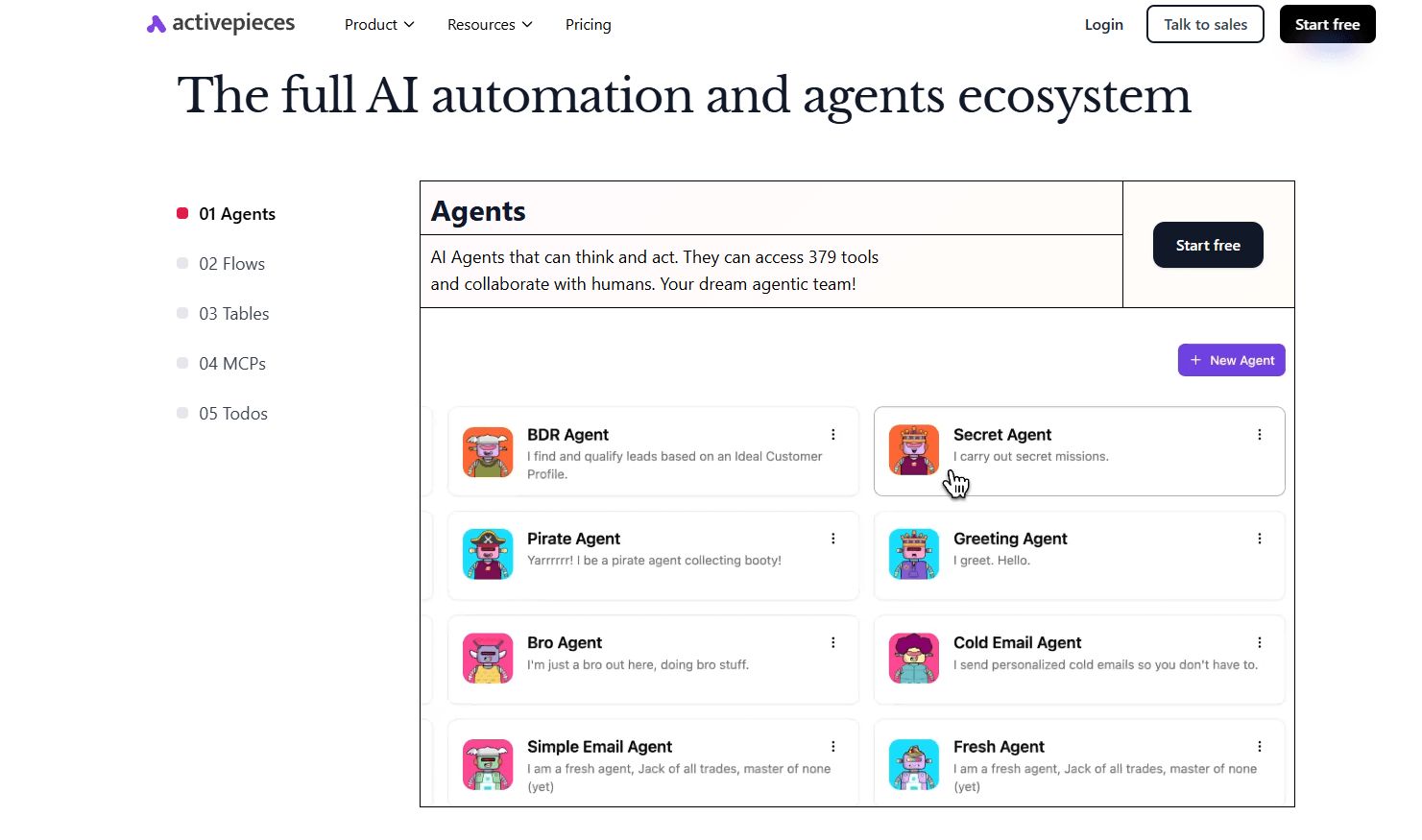
Stop fixing broken processes or repeating the same steps every week. With Activepieces, you can run workflows without needing a large IT staff. The no-code builder makes it easy for non-technical users, while developers get the freedom to extend flows with AI and TypeScript.
You don’t have to give up the tools you already rely on, either. With 379+ integrations, Activepieces connects smoothly with third-party apps so you can build workflows that match the way you already work.
Your team will spend less time on repetitive tasks and more time on work that moves the business forward. That means higher overall productivity now, and a stronger foundation for long-term success later.
Talk to our sales team today and explore how we can transform your workflows together!
FAQs About AI Workflow Automation Tools
What is the best AI workflow automation tool?
The best tool integrates seamlessly with your existing systems, handles complex processes, and connects different apps while maintaining strong data quality. Activepieces combines the ease of no-code platforms with advanced AI models, which helps operations managers boost service delivery and ease the IT team’s workload.
Can AI be used for workflow automation?
Yes. By adding AI, you can run smarter data analysis, use AI models for specific tasks, and cut hours of manual work.
Which AI is best for automation?
The best AI depends on your business goals. Some teams need general-purpose AI, while others benefit from industry-focused AI models that adapt to their workflows.
What is an AI automation tool?
An AI automation tool combines automation with artificial intelligence to go beyond legacy systems or traditional tools. These platforms use AI to process information, adapt flows, and deliver intelligent workflows that support long-term success.


